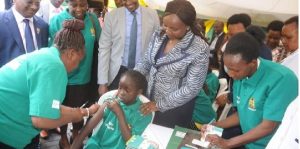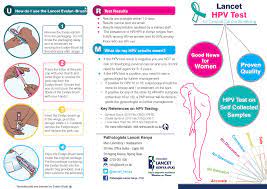Human papilloma virus (HPV) is the leading cause of anogenital cancers globally with cervical cancer as the top cause of cancer- related deaths in women.
Over 90% of these deaths occur in low income countries where cancer control strategies remain inadequate. HPV vaccination provides protection against HPV types 16 and 18 which are responsible for approximately 70% of cervical cancer cases.
The optimal age of vaccination is in the early adolescent period, before sexual debut with possible HPV infection. Studies have shown that children residing in low income settlements are at risk of early initiation of sexual activity.
Adolescent vaccination programs would provide an avenue to link other health promotion strategies targeting this age group that has hitherto been left out of many health interventions in 2019, Kenya introduced HPV vaccine to be given to 10 year old girls.
Uptake has been sub-optimal with only 33% of targeted population receiving the first dose in 2020 and 16% returning for the 2nd dose. While disruption of immunization programs by the COVID-19 pandemic contributed to the low coverage, other factors such as low demand fuelled by misinformation have also played a role.
Keywords: Human Papilloma Virus (HPV), girls, Kenya, vaccine, uptake, adolescent
Importance of This Review Paper
Vaccination is one of the most important and equitable public health strategies in existence to combat infectious diseases globally (1). Persistent Human Papilloma Virus (HPV) infection in the genital tract is the leading cause of anogenital carcinomas (2). Cervical cancer is of special concern because of the internal location of the cervix as well as the occult cancer presentation in early stages, implying that active screening in the at-risk women must be done regularly to detect pre-cancerous and early stage cancer lesions.
In most low-income countries, access to centers that carry out screening and diagnosis is limited and awareness of the need for regular pap-smears is also low leading to many women presenting with advanced cervical carcinoma.
HPV vaccines have been shown to be effective in preventing HPV infection when administered in young boys and girls before their sexual debut.
In countries with high vaccine coverage such as Australia which reported a HPV vaccine coverage of 80% in females and 76% in males in 2019 (3), a significant decline in vaccine type-HPV infection and high grade precancerous cervical lesions has been reported with a substantial impact on cervical cancer incidence expected in the coming years (4).
Routine HPV vaccination was introduced in Kenya in late 2019 to 10 year old girls. Uptake has been sub-optimal owing to various challenges that we seek to elucidate in this review.
Background of HPV Associated Illnesses, HPV Vaccines and Adolescent Vaccination.
Human Papilloma Viruses comprise over 100 serotypes of which about 14 are of oncogenic potential.
These high-risk viruses are sexually transmitted and cause a majority of oral and ano-genital cancers in both males and females.
The non-oncogenic types cause cutaneous and mucosal warts including sexually transmitted oropharyngeal and ano-genital warts (5). Cervical carcinoma, one of the HPV-related cancers is of great public health concern as it is the leading cause of cancer deaths in females world-wide. In 2020, there were over half a million cases of cervical cancer globally with over 300,000 deaths.
Ninety percent of these deaths occur in low income countries where cancer control strategies remain inadequate . In 2020, Kenya reported over 5,000 new cases of cervical cancer and about 3,000 deaths from cervical cancer complications .
HPV vaccination is one of the primary prevention approaches in the comprehensive cancer control strategy used in tandem with promotion of abstinence, faithfulness to one partner and condom use.
Adolescent vaccination is one of the strategies toward implementing the life-course immunization approach set out in the Immunization Agenda 2030.
This approach expands the coverage of routine immunization to other age groups outside infancy and also seeks to improve coverage in under-served populations under the mantra “reaching everyone, everywhere”.
Young adolescents, classified as children between 10 and 15 years, have been left out of many public health programs and yet remain vulnerable to many health threats.
Promotive and preventive interventions targeted toward this group are likely to have a greater impact on future health and well-being with far-reaching implications on productivity across generations.
Recent studies have shown that the age of sexual debut is earlier than that depicted in past reports drawn from census data that classifies adolescents in the 15–24 years age bracket, missing the younger adolescents.
A study carried out in 2013 among boys and girls aged 12–16 years, living in two large informal settlements in Nairobi Kenya, further explored the predictors of early sexual debut.
It emerged that family dysfunction and lack of parental supervision were leading factors associated with early engagement in sexual intercourse. Adolescents enrolled in schools were found to be protected from early sexual debut.
Many of the young adolescent girls in hard-to-reach populations such as low income settlements and nomadic communities do not attend school regularly and reaching them with HPV vaccination was anticipated to present a substantial challenge.
A purely school based approach to vaccination would fail to capture them and hence the government decided to use a facility based approach with community and school mobilization by teachers and other identified community members. Stakeholders involved in the roll out had to come up with strategies to address potential barriers. The key strategies employed to sensitize the community included getting community leaders to endorse the vaccine in collaboration with the government and providing simple but accurate information to the community using creative and engaging methods such as skits and media talk shows.
Promoting behavior change as a lone strategy for preventing sexually transmitted infections has been shown to be ineffective in reducing transmission and would hence not be effective for prevention of HPV infection as well. Behavior change must be linked to other prevention strategies such as condom use, vaccination and screening.
There are 3 vaccines currently approved for prevention of HPV. All the three types offer protection against HPV serotypes 16 and 18 that cause 70% of cervical cancer with the latest nanovalent HPV vaccine offering an additional 20% protection against 31, 33, 45, 52 and 58 which are other high risk serotypes for ano-genital cancers.
The quadrivalent and nanovalent HPV vaccines also protect against types 6 and 11, responsible for ano-genital warts as well as the rare vertically transmitted respiratory papillomatosis.
HPV vaccines are licensed for use in both boys and girls between 9 and 26 years of age, with the optimal age of administration being 9–14 years of age. This is considered to be the most appropriate age for vaccination as most of the children have not had any sexual encounters by then and therefore unlikely to have acquired HPV infection .



